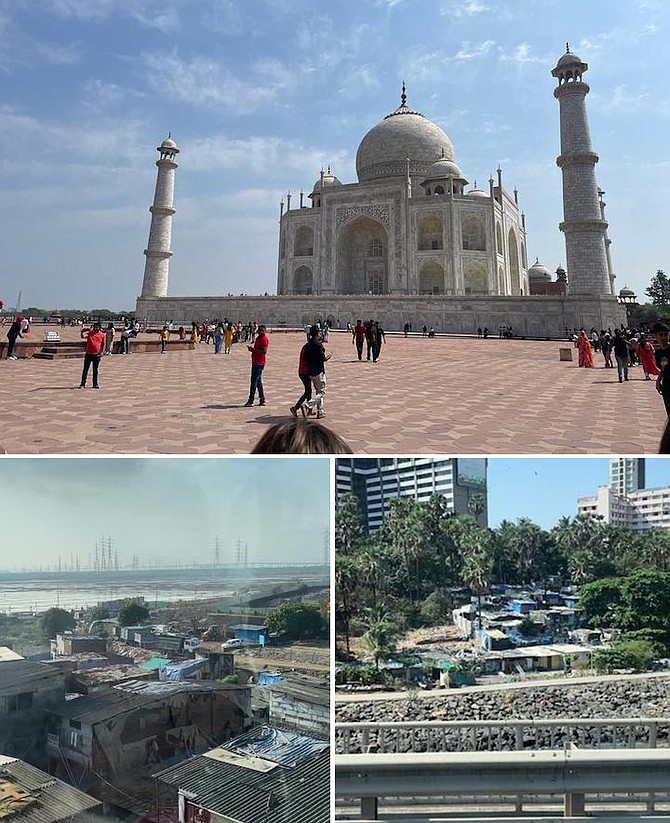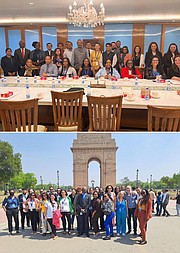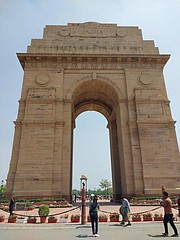The iconic Taj Mahal, the opulent memorial built in 1632 for Mughal emperor Shah Jahan’s favourite wife, stands in sharp contrast to the bitter poverty experienced in the slums in other parts of India, along with the haze of pollution that hangs over other parts of the nation. Photos: Leandra Rolle
By LEANDRA ROLLE
Tribune Staff Reporter
lrolle@tribunemedia.net
FROM its rich history to its colourful heritage and diverse culture, India has a lot to offer. It was a fact that I became increasingly aware of each day during my visit to the country last month.
I stayed in India for about a week and was part of a 30-plus member media delegation from LAC (Latin American and Caribbean) countries on a familiarisation trip there that was fully funded by the Indian government.
It took us nearly a day, on in some cases two, to arrive in New Delhi, the country’s capital.
But it took considerably less time for many, including myself, to realise that India had a promising future and the potential to become a global superpower.
And make no mistake, India – which has a population of over one billion people and remains the world’s fastest growing economy - is well on its way to achieving such status.
For one, the country’s heavy focus on digital transformation and using tech-based solutions was a key message often stressed by government officials during meetings held with the delegation.
Nagarj Naidu Kakanur, of the Ministry of External Affairs, summed it up best when he told the media group: “We are of the view that the digital dimension is something really needs to be focused on.”
“There is a global digital divide and at the same time, people forget that there is an emerging data divide. Today, every country, in order to meet your sustainable development goals needs to be backed up by data.”
From restaurants to roadside shops, QR coded sound boxes can be seen set up, allowing for customers to make digital payments on their phones.
Digital transactions like money transfers can also be made on smartphones via a WhatsApp payment feature.
Other transformative initiatives undertaken by the Indian government to support their push towards digitisation includes the distribution of national biometric identity cards.
Referred to as Aadhaar card, it uses a 12-unique identity digit number which is also linked to a person’s biometric data such as fingerprints, etc.
“What we have done in India is that practically a hundred percent of all adults in India today have biometric digital identity cards,” said Mr Nakaknur. “Uniquely printed, all of them, we have something called unique identity numbers and we have mapped that number with your biometrics.”
“What has happened is that you have linked a billion plus people with a billion bank accounts, so this is completely transformational. This is something called the foundational digital public infrastructure.”
Another interesting fact is that people in India do not need money to open a public bank account, according to officials.
“People thought nobody can open bank accounts without money but India came up with the concept that you won’t need to have money to open a bank account so that’s fundamentally changed everything,” Mr Kakanur added.
“Everybody thought that you need to be approved to have a bank account, but India reversed it. The government here said that ‘no, you are a person, you deserve an account, irrespective of the fact that you maintained a zero balance, or you put in money.”
“But when everybody felt that they have a bank account, it forced them to pull out their savings which they’re hiding in their homes into the financial system. Doing so, you brought in over $250b more into your banks just by one single initiative.”
“So, this is something called transformational … and we would like to take it globally and so we’re really pioneering that concept of digitisation, digital health, digital agriculture (and digital education.”
But, despite India’s growing economy and its ambitious plans for the future, the country still has its fair share of challenges and a long road ahead of it as it relates to tackling pollution and high levels of poverty.
Scattered on the outskirts in cities like New Delhi and Mumbai lies a number of slums, where thousands of impoverished Indians live in squalor.
On one side stands either tall apartment buildings or pristine skyscrapers.
And lying right across from it is a group of dilapidated, and cramped tin shacks.
The makeshift homes were a common sight seen in India and exposed the harsh living conditions of many of the Indian people.
Meanwhile, sprawled across the streets in many areas lies trash cans, discarded food scraps and other garbage items.
But besides that, air pollution is also a serious environmental problem facing the country.
Most, if not all, mornings, the delegation awoke to see a smoky haze hanging over their city, serving as a reminder of the poor air quality there.
But, the issue of air pollution is a problem that’s not lost on the Indian government, with officials said to be making headway to address the issue.
And as one of the most disaster-prone countries in the world, climate preparedness and resiliency is another major area of focus for the government.
“There is no substitute to local level preparedness,” said Kamal Kishore, secretary in charge of India’s National Disaster Management Authority (NDMA).
“Even if you issue a warning, what’s really important is that people know what to do with that warning. In our country, we reduce mortality from cyclones by something [like] 95 percent and a key aspect of that is local level preparedness … so communities, villages and urban areas are prepared.”
“They know what to do. They take a forecast and warning seriously. They evacuate and they go into cyclone shelters and when the cyclone has passed, they come back.”
Ahead of an impending storm or natural disaster, the government utilises a common alerting protocol system that sends out targeted alerts to its citizens.
“So, you don’t put out a general-purpose warning for everyone … it’s a very targeted (system) and the more precise of your boundary or where the impact is likely to be high, the more likely that people will take it seriously,” added Kishore.
From hearing about the government’s digitisation plans to seeing its approach to natural disasters, my trip to India can definitely be described as an insightful one and I think it is well positioned to expand its global outreach.







Comments
Alan1 11 months, 1 week ago
A very interesting article. I have also visited India and it is a fascinating place.
Sign in to comment
Or login with:
OpenID